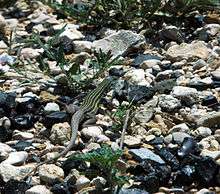Texas spotted whiptail
| Texas spotted whiptail | |
|---|---|
 | |
| Scientific classification | |
| Kingdom: | Animalia |
| Phylum: | Chordata |
| Class: | Reptilia |
| Order: | Squamata |
| Family: | Teiidae |
| Genus: | Cnemidophorus |
| Species: | C. gularis |
| Binomial name | |
| Cnemidophorus gularis | |
| Synonyms | |
| |
The Texas spotted whiptail (Cnemidophorus gularis or Aspidocelis gularis) is a species of long-tailed lizard native to the southern United States, in Texas, New Mexico, and Oklahoma, and northern Mexico in Coahuila, Nuevo León, Tamaulipas, San Luis Potosí, Querétaro, and Veracruz.
Description

Texas spotted whiptails grow 6.5 to 11 inches (17 to 28 cm) in total length (including tail). They are typically a tan brown or green-brown in color, with a pattern of seven distinct grey or white stripes that run the length of the body, and stop at the tail, with light colored spots along the sides. The underside is uniformly white in color. Males often have a red-colored throat, blue belly, and black or blue patches on the chest, while females have only a pink-colored throat. The tail is long compared to the body, usually close to three times the body length. The tail is usually a uniform peach or tan color.
Behavior & habitat
C. gularis are diurnal and insectivorous. They are highly active and found in a wide variety of habitats, from grassland and semi-arid regions, to canyons and rocky terrain, typically not far from a permanent water source.
Reproduction
Breeding of sexually mature C. gularis occurs in the spring, and a clutch of 1-5 eggs is laid in the early summer.
Subspecies
Some sources list six subspecies of the Texas spotted whiptail:
- Cnemidophorus gularis gularis Baird & Girard, 1852
- Cnemidophorus gularis colossus Dixon, Lieb & Ketchersid, 1971
- Cnemidophorus gularis pallidus Duellman & Zweifel, 1962
- Cnemidophorus gularis rauni Walker, 1967
- Cnemidophorus gularis semiannulatus Walker, 1967
- Cnemidophorus gularis semifasciatus Cope, 1892
Etymology
The subspecific name, rauni, is in honor of American zoologist Gerald George Raun (born 1932).[2]
References
- ↑ IUCN (2016). "Aspidoscelis gularis ". IUCN Red List of Threatened Species. Version 2016.3. International Union for Conservation of Nature. Retrieved 7 December 2016.
- ↑ Beolens B, Watkins M, Grayson M (2011). The Eponym Dictionary of Reptiles. Baltimore: Johns Hopkins University Press. xiii + 296 pp. ISBN 978-1-4214-0135-5. (Aspidocelis gularis rauni, p. 217).
Further reading
External links
| Wikimedia Commons has media related to Cnemidophorus gularis. |
